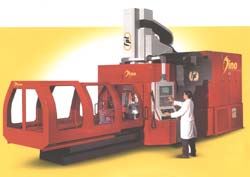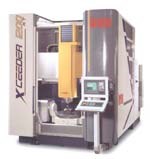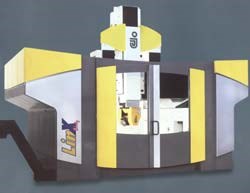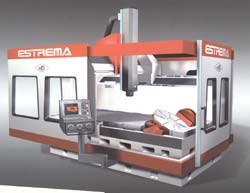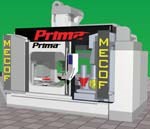High Speed Machining, Italian Style
One of the highlights of BI-MU, Italy's recent biennial machine tool show, was the number of innovative machine tools (and related technology) focusing on high speed machining.
Share





One of the highlights of BI-MU, Italy's recent biennial machine tool show, was the number of innovative machine tools (and related technology) focusing on high speed machining. The show, held in Milan in even numbered years, indicated some clear trends in high speed applications for die/mold and aerospace customers. The high speed machines on display at BI-MU show that larger machines are getting faster. Large structures that can sustain high rates of acceleration and deceleration are emerging, apparently due to advances in computer analysis leading to more rigid designs along with a growing use of linear motors. Linear motors are now gaining in efficiency but are becoming more economical.
Rigid designs combined with spindles capable of delivering high torque values at high spindle speeds are allowing high speed roughing and high speed finishing to occur on the same machine in one setup. Simultaneous five-axis machining is also growing in prevalence, especially in configurations utilizing tilting and rotating tables. Some machines feature five-axis spindle heads that can be locked into place for greater rigidity in three-axis roughing operations.
There is a trend toward longer worktables on some models, allowing more than one workpiece to be set up for extended operation in the untended mode. In some cases, enclosures allow one end of the table to be closed off so that operations can resume while finished work is removed from the other side of the table.
Italian builders tend to favor Fidia, Heidenhain or Siemens CNCs for their high speed machines, but many are now offering Fanuc control units as an appeal to the North American market, where this brand is well established. Even a small selection of high speed milling machines on display at BI-MU attests to the dynamic level of development efforts in Italy.
Interesting Approach To Roughing
FPT's Dino is designed for both high speed roughing and high speed finishing. According to developers, this portal-style machine has the rigidity for roughing along with the nimbleness for finishing. Roughing is performed with a 45-hp fixed vertical spindle (top speed of 12,000 rpm). The company is promoting a concept that favors roughing with a relatively small tool at lighter depths (a 50-mm cutter at 1.0 mm DOC, for example) making many passes, thus avoiding the stresses too severe for machines designed for finishing only. While this strategy does not reduce overall roughing time compared to more conventional roughing with a larger tool at heavier cuts, it does reduce semi-finishing to essentially a remachining operation that cleans up material unreachable with the roughing tool. Overall machining time is reduced.
Semi-finishing and finishing are performed with a universal head that allows an HSK-63A tool to be oriented in five axes to cut with the most efficient part of the cutter. This 24-hp spindle has a top speed of 18,000 rpm for semi-finishing. For finishing, this spindle accepts a 34,000-rpm, 22.8-hp electrospindle for HSK-40E tooling. The universal head rotates 50 degrees to reach mild undercuts in molds or dies that might otherwise require a second setup.
Lining Up With Linear Motors
MECOF's new Prima machining center is equipped with linear motors in the X, Y and Z axes for 1.1 g acceleration and cutting speeds as high as 60,000 ipm (100,000 ipm for rapid traverse). The machine can change heads automatically, switching from a 40-hp fixed vertical head for roughing at a top speed of 18,000 rpm, to a rotary head with an electrospindle for finishing. The rotary head can be one of two types—a two-axis continuous model for five-axis machining at 26,000 rpm, or a two-axis positioning model for three-axis machining at 30,000 rpm.
With a 65 by 31.5 by 55-inch workzone, the Prima is targeted to die/mold and small aerospace components. For graphite electrodes, a dust suction system can be installed. For larger aerospace parts, MECOF offers the AirOne series, which is essentially the same machine configured with additional worktable modules that extend the X axis up to 945 inches long.
Perhaps the most ambitious use of linear motors appears in the Estrema milling machine introduced at the show by Gruppo Parpas. Along with the X, Y and Z axes, linear motors are used for the tilting and rotating table, giving it the speed to keep up with the other three axes. The rotary table is located off to one side of the extra long table so that the other side can be used for three-axis machining.
High Speed Or Multi-Purpose
Well established as a builder of milling machines for marble and stone, Breton only recently began designing and building machines for the metalcutting industry. The company's Xceeder and Ultrix machines are especially interesting. These machines are basically the same platform configured either for high speed machining or for multipurpose machining. These portal-type, traveling-column machines feature a "Metalquartz" base consisting of a steel frame filled with a quartz polymer composite for rigidity, vibration damping and resistance to thermal distortions.
The Xceeder can be configured in three ways. The basic version is a three-axis machine with a fixed table for dies, tooling and aerospace parts. A high-production version comes with a rotating table for simultaneous setup and machining. Finally, a five-axis version incorporates a rotary tilting table for complex aerospace parts, engine blades and contoured mold and die surfaces. Three high frequency spindles are available: a high-torque (73.7 foot-pounds) model for roughing and finishing (18,000 rpm top speed), a mid-range model for roughing and finishing of steel and light alloys (rated at 28 foot-pounds and a top speed of 24,000 rpm) and a high-rpm model for fine-finishing of dies (rated at 7.4 foot-pounds and a top speed of 40,000 rpm).
The Ultrix reconfigures this platform with a rotary table that functions both as a fourth axis for milling and a lathe spindle for turning operations. For turning, a separate unit is added to the milling spindle to hold and to feed tooling bars for turning cutters. At the show, this machine was equipped with powered grinding tools and a wheel dresser. Thus, a part could be milled, drilled, turned and ground in one setup.
Fast In Five-Axis Applications
JOBS introduced its LinX Blitz five-axis milling machine. The Blitz is the smallest model in the LinX series, yet it is designed for medium size components in die/mold, energy, aerospace and general machining categories, with a work envelope of 67 by 86 by 35 inches in X, Y and Z. These axes are all driven by linear motors with a top speed of 2,756 ipm and 1.0 g of acceleration.
The machine has an automatic head changer, allowing it to use a fixed vertical head for three-axis roughing and semi-finishing, or a continuous two-axis head for finishing in full five axes. Two spindle motors are offered, a 9,000-rpm version (rated at 92 foot-pounds) strictly for three-axis milling, or a 24,000 rpm version for simultaneous five-axis machining. This spindle is rated at 31 foot-pounds torque.
Although best known for its highly capable CNC units and its innovative programming software, Fidia also builds five-axis milling machines. At this show, Fidia was showing the K197, developed for machining medium-size workpieces such as very deep complex molds that are typical of household appliances and electronic products. The 43-hp spindle has a top speed of 24,000 rpm.
The company was also showing a remarkable new laser tool measurement system, the TMSC100. By passing the rotating cutting tool through the laser beam, this device very accurately locates and measures the tool's geometry to calculate the precise tool center point. Because toolpath offsets are based on this center point, using precise measurements rather than theoretical values allows high speed machining to yield more accurate workpiece geometry. The system detects and compensates for any eccentricity caused by inaccuracy or deterioration of the toolholder or any imbalance of the tool/toolholder assembly.
High Speed For Productivity
A good reminder of how prevalent high speed technology has become in production machining is provided by Mandelli's new Thunder horizontal machining centers. This series of models, introduced at the show, has high spindle speeds and high feed rates suitable for aluminum workpieces, yet has the high power and high spindle torque for workpieces of steel and cast iron. A range of spindles with speeds as high as 24,000 rpm and torque values up to 258 foot-pounds can be matched to the application.
A key element for productivity in high volume applications is palletization, so the Thunder machining centers can be configured with various pallet changing systems. The machines can also be incorporated into cells. The Thunder is available in three sizes, for 500-, 630- or 800-mm pallets. For rough and finish machining of medium to large workpieces, Mandelli offers its Storm series of horizontal machining centers. These machines have been upgraded recently for higher axis travel as displayed at the show.
A Flair For Aesthetics
Although technical specifications rightfully claim their priority in discussions about machining applications, it has to be noted that machine tools from the Italian builders are uncommonly attractive pieces of equipment. Few opportunities are missed to use clean lines, smooth curves and sound proportions on the outside to reflect solid engineering and craftsmanship in the mechanics underneath.—MDA
Related Content
Orthopedic Event Discusses Manufacturing Strategies
At the seminar, representatives from multiple companies discussed strategies for making orthopedic devices accurately and efficiently.
Read MoreCNC Machine Shop Honored for Automation, Machine Monitoring
From cobots to machine monitoring, this Top Shop honoree shows that machining technology is about more than the machine tool.
Read More5 Tips for Running a Profitable Aerospace Shop
Aerospace machining is a demanding and competitive sector of manufacturing, but this shop demonstrates five ways to find aerospace success.
Read MoreInside a CNC-Machined Gothic Monastery in Wyoming
An inside look into the Carmelite Monks of Wyoming, who are combining centuries-old Gothic architectural principles with modern CNC machining to build a monastery in the mountains of Wyoming.
Read MoreRead Next
Registration Now Open for the Precision Machining Technology Show (PMTS) 2025
The precision machining industry’s premier event returns to Cleveland, OH, April 1-3.
Read More5 Rules of Thumb for Buying CNC Machine Tools
Use these tips to carefully plan your machine tool purchases and to avoid regretting your decision later.
Read MoreSetting Up the Building Blocks for a Digital Factory
Woodward Inc. spent over a year developing an API to connect machines to its digital factory. Caron Engineering’s MiConnect has cut most of this process while also granting the shop greater access to machine information.
Read More











